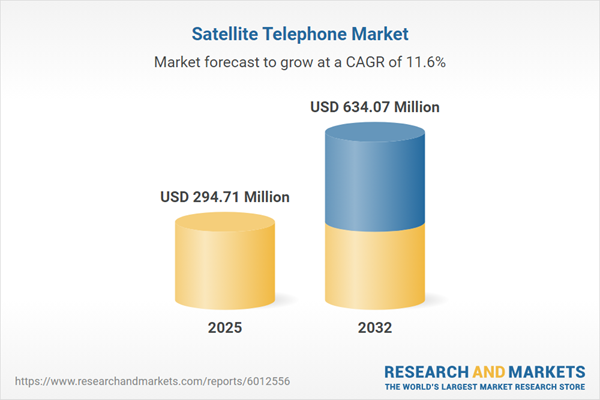Speak directly to the analyst to clarify any post sales queries you may have.
Satellite telephone technology provides enterprises with reliable, secure connectivity in locations beyond the scope of traditional networks. Senior executives in sectors including defense, logistics, and emergency services depend on satellite phones to maintain uninterrupted communication, uphold compliance mandates, and ensure operational continuity in dynamic and challenging environments.
Market Snapshot: Satellite Telephone Market Size and Growth
The global satellite telephone market is experiencing robust expansion. For 2024, the market is valued at USD 263.78 million, with expectations to reach USD 294.71 million by 2025. This growth is propelled by a compound annual growth rate of 11.58%. Enterprise demand for secure, always-on communication solutions drives market momentum, particularly among organizations prioritizing risk mitigation, regulatory adherence, and the ability to rapidly adapt their network infrastructure. As technology standards evolve, satellite telephone systems are steadily becoming core components in global business continuity and risk management frameworks.
Scope & Segmentation of the Satellite Telephone Market
This report equips business leaders with actionable insights to shape technology investments, plan geographic expansion, and refine strategic direction. Detailed segmentation allows stakeholders to align decision-making with operational goals and emerging market opportunities.
- Product Types: Aviation satellite telephones ensure dependable in-flight communication, fixed units connect remote or unmanned sites, handheld solutions secure field team communications, and vehicle-mounted systems facilitate contact for fleets operating in adverse or isolated locations.
- Network Types: Geostationary, low Earth orbit, and medium Earth orbit constellations each present unique trade-offs in network latency, coverage scope, and reliability to address critical deployment needs.
- Frequency Bands: C-Band, Ka-Band, Ku-Band, L-Band, and S-Band are leveraged for their specific technical attributes and suitability to regulatory environments and operational demands.
- Applications: Key use cases include aviation safety, maritime operations, government and military missions, logistics management, emergency response, and international broadcasting—each relying on prompt and secure communications.
- Regional Coverage: Analysis extends to the Americas, Europe, Middle East & Africa, and Asia-Pacific, evaluating how local regulations, technology adoption, and readiness levels affect market access strategies and business development.
- Key Companies: Major industry players such as Iridium Communications Inc., Inmarsat plc, Globalstar Inc., Thuraya Telecommunications Company, and Eutelsat S.A. are advancing network innovation and shaping sector competition.
Satellite Telephone Market: Key Takeaways for Senior Decision-Makers
- Low Earth orbit networks offer enhanced resilience, making them a preferred option for industries requiring dependable connectivity in areas without terrestrial infrastructure.
- Pairing satellite with ground-based networks increases operational surety and maintains communication during events such as infrastructure interruptions or extreme weather.
- Regulatory modernization supports accelerated spectrum management and facilitates seamless multinational service rollouts.
- Collaboration among manufacturers, systems integrators, and distributors is accelerating adoption rates in sectors including defense, logistics, and energy.
- Flexible regional coverage and infrastructure adaptation are vital for organizations focusing on emergency response, maritime operations, and other geographically distributed missions.
- Cross-border partnerships are streamlining regulatory alignment and enhancing success rates for international projects.
Tariff Impact: Navigating Supply Chain and Pricing Challenges
Recent updates to U.S. tariff policy have introduced new supply chain and pricing considerations for satellite telephone hardware suppliers. Leading companies are actively diversifying supply sources and increasing localized production to mitigate potential risks and reduce exposure to financial uncertainties. Adjustments to pricing structures and supplier agreements are advised to sustain competitiveness as regulations evolve. These adaptations are central to ensuring continued organizational flexibility and resilience within the sector.
Methodology & Data Sources
The research behind this report blends insights from executive-level interviews, industry analyst commentary, company disclosures, regulatory filings, and curated business intelligence databases. Cross-verification of data ensures validity, enabling strategic decisions supported by trustworthy findings.
Why This Report Matters
- Enables leaders to recognize and act on emerging satellite telephone market opportunities early in the decision cycle.
- Facilitates the creation of reliable communications infrastructure that addresses compliance and limits operational risk as business conditions shift.
- Provides a consistent benchmark for technology evaluation and strategic navigation amid evolving supply chain and regulatory contexts.
Conclusion
This analysis offers senior decision-makers the clarity needed to prioritize investments, reinforce resilience, and capitalize on opportunities emerging from rapid developments in satellite telephone communications.
Additional Product Information:
- Purchase of this report includes 1 year online access with quarterly updates.
- This report can be updated on request. Please contact our Customer Experience team using the Ask a Question widget on our website.
Table of Contents
3. Executive Summary
4. Market Overview
7. Cumulative Impact of Artificial Intelligence 2025
Companies Mentioned
The companies profiled in this Satellite Telephone market report include:- Iridium Communications Inc.
- Inmarsat plc
- Globalstar, Inc.
- Thuraya Telecommunications Company
- Eutelsat S.A.
Table Information
| Report Attribute | Details |
|---|---|
| No. of Pages | 184 |
| Published | October 2025 |
| Forecast Period | 2025 - 2032 |
| Estimated Market Value ( USD | $ 294.71 Million |
| Forecasted Market Value ( USD | $ 634.07 Million |
| Compound Annual Growth Rate | 11.5% |
| Regions Covered | Global |
| No. of Companies Mentioned | 6 |









